Last Updated on March 23, 2022 by Grow with Bovees
When to prune Rhododendrons? There are several times during the year when you should carry out certain aspects of trimming rhododendrons. Early spring is generally the best time for most of your rhododendron pruning activities.
Certain pruning tasks can be carried out at other times of the year, depending upon what stage of blooming your rhododendron plants are at.
Rhododendrons are fairly easy to maintain as long as you know when and how to prune and plant these beautiful flowering plants.

Rhododendrons can quickly require some pruning to keep the plant both under control and beautifully landscaped. To do this, you will need to know when and how to prune rhododendrons.
- When to Prune Rhododendrons
- How to Prune Rhododendrons
- Pruning Rhododendrons For New Growth
- Rejuvenation Pruning Of Old Rhododendrons
- Severe Pruning of Rhododendron When They Are Too Big
- What Zones are Suitable for Rhododendrons?
- Conclusion: Why You Should Plant Rhododendrons and How to Keep them Maintained
When to Prune Rhododendrons
The Rhododendron plant requires little care to produce healthy and wholesome blossoms, but this does not mean they are a low-maintenance shrub. In fact, neglecting to maintain the overall shape and size of your rhododendron can cause the shrub to grow irregularly and out-of-control.
Because of this, you will need to remember they do require maintenance pruning each year to see the best of next year’s flower buds. (But don’t worry if you are reading this after years of neglect. We can help with that, too!)
How To Trim Rhododendron Shrubs — Maintenance Pruning
When pruning rhododendrons for yearly maintenance, they will need to be pruned in late winter while the plant is dormant. Maintenance pruning simply means that the plant is pruned to maintain its health while removing the dead flowers and wood. Leaving these dead flowers and wood on the plant can reduce the number of flowering blossoms that are produced the following year.
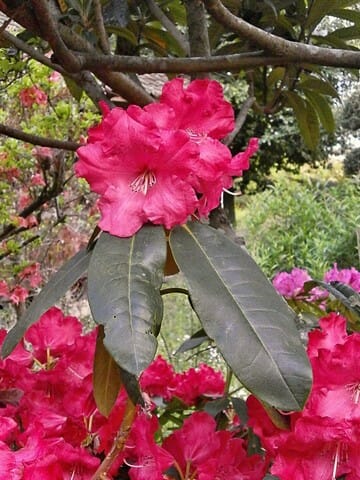
Pruning rhododendrons during late winter while the plant is dormant will allow flowers to bloom the following year. Pruning during a time when energy is still being distributed throughout the plant to different flower stems, blooms, and wood will likely result in little to no blooms in the following year.
If it is not possible to prune in late winter, you can prune dead wood, leaves, and flowers any time after the first frost of fall. Once the first frost has occurred, the plant will be dormant, which means there is no energy being distributed throughout the plant to the different blooms, flowers, or wood.
This means the plant will bloom the following year. You will likely need a couple of tools for this, anvil pruners for the thinner branches and stems, and bypass pruners for the thicker branches.
For the really thick branches, using a pole saw or a small chainsaw or may be required. For trimming higher branches, the use of a telescopic pole saw is recommended.
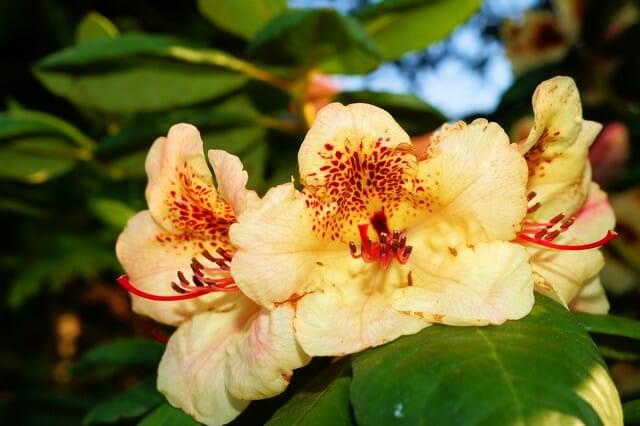
If you prune during the growing season when blooms and branches are still growing, they will not produce blooms the following year. This makes it imperative for rhododendrons to be pruned during cold months, preferably late winter, while the shrub is dormant.
How to Prune Rhododendrons
To prune your rhododendron bush, you will need a pair of pruning shears or some of these Fiskars loppers, depending on the type you are pruning. For example, azaleas can typically be pruned with handheld pruning shears as the wood of azaleas is small and thin. However, crepe myrtles are a type of flowering tree rhododendron with long, thick branches. These flowering trees require loppers that can extend and cut through the density of the branches.
Each fall, you should fertilize your rhododendrons so that the new growth that comes from pruning can be rich and full. Failing to fertilize your rhododendrons can cause new growth to be leggy. Leggy specimens will only have the flower cluster on the outside branches of the plant, rather than deep within the shrub. This causes your shrub to look sparse rather than full.
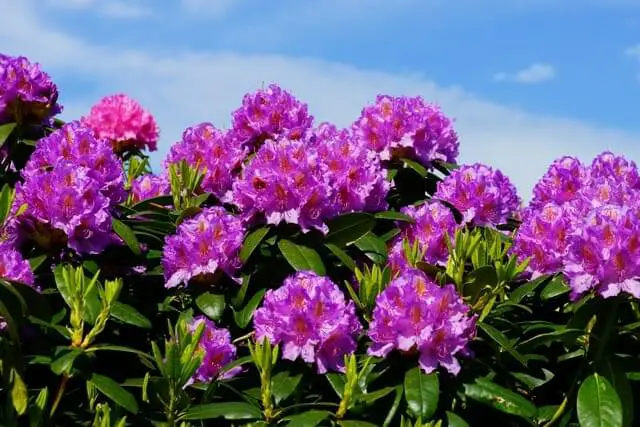
To perform yearly maintenance In late winter, take your pruning shears and cut off all the spent flowers. Depending on how big the rhododendron is, you may be able to cut back 15 to 20 inches of each branch of the plant. Because the rhododendron species are not meant to be cut in a shape, each primary branch that you cut should be cut at different heights to make the shrub appear natural.
Pruning Rhododendrons For New Growth
When making your cuts, you should cut between ½ to ¾ of an inch above or before a dormant bud, these are called latent buds. This will help the plant produce more flower clusters in the following year.
Rejuvenation Pruning Of Old Rhododendrons
As we mentioned, it is easy for your rhododendron to overgrow due to years of neglect. Even forgetting to prune rhododendrons for just one season can cause overgrowth in the following year.
Without routine maintenance, rhododendron can become overgrown and leggy. It will have taken growth into its own hands by sprouting new shoots, branches, and blooms wherever the energy of the plant tells it to grow.
While this is indicative of a healthy plant, it can quickly become overgrown and unsightly. Therefore, you will need to trim the old growth so that the shrub regain its natural shape.
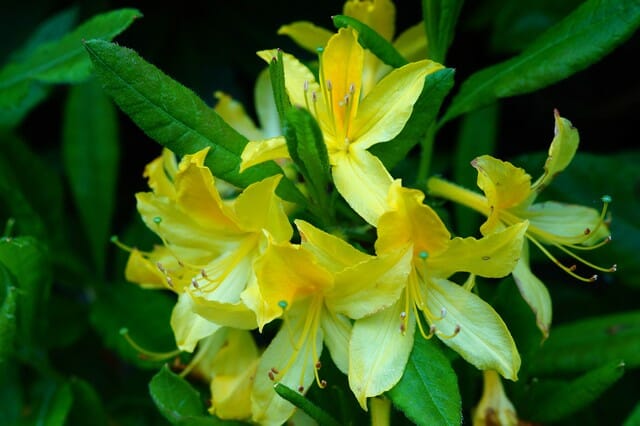
To do this, you will first need to prune all the old wood. These pieces of wood may be dead or diseased wood that is growing irregularly. Depending on how out-of-control the rhododendron is will determine just how much pruning you must do. Pruning old specimens may entail cutting back the old wood, any dead branches and some main branches, similar to routine maintenance.
Some rhododendron may be so overgrown that you will need to cut back all the branches of the shrub. This is known as rejuvenation pruning. Rejuvenation pruning means that you cut off all the dead and irregular branches so that most of the shrub is cut back to a small, basic shrub.
The best place to cut the rhododendron branches when performing rejuvenation pruning is about ½ to ¾ of an inch above a healthy flower bud. This will allow new healthy branches to form in the following year because the energy of the shrub is being told where to go rather than deciding on its own where it should grow new branches. If you are thinking of using a wound sealant after pruning, check out our page at that link.
Severe Pruning of Rhododendron When They Are Too Big
Oftentimes, a rhododendron bush that has been neglected for years and has become so overgrown that it requires hard pruning.
Major pruning means that you cut the entire rhododendron down to the primary branches of the shrub, as low as 6 inches (15.24 cm) off the ground, if possible. Some rhodo species can survive being cut back to 6 inches (15.24 cm), while other species cannot.
To severely prune your rhododendron, you will want to prune in late winter, just as you would prune for regular maintenance. However, before cutting your entire rhododendron down to 6 inches and hoping the entire shrub does not die, we recommend leaving one branch in place while cutting the remaining branches back to 6 inches.
If the branches you cut back to 6 inches sprout new growth, then you know that your rhododendron can survive being severely pruned. Should you cut all the branches down to 6 inches, and it not survive, you have no healthy branch to help the rhododendron regrow the following year. For this reason, we recommend cutting all but one branch down to 6 inches to make sure the rhododendron can survive the heavy pruning.
Hard pruning of rhododendron will not produce any flowers the following year. This type of rhododendron pruning of is done to correct years of neglect that has led to overgrowth and leggy flowers.
When severely pruning your rhododendron, it is important to remember to be patient. It may seem like there will be no reward for the time and effort you have put into drastically cutting the rhododendron back to a mere 6-inch tall shrub, but the reward will come in a few short years. You will have a well-maintained and lush flowering shrub that you will be able to easily and routinely maintain each year.
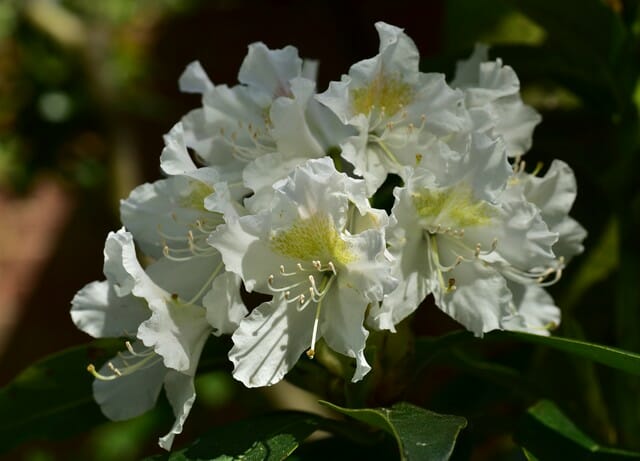
What Zones are Suitable for Rhododendrons?
Zones are assigned by the USDA to each climate and soil hardiness that is found throughout the United States. These zones are numbered 1 through 13, and each zone is separated by 10 °F. The colder the climate, the lower the number. The hottest and most tropical climates are from 10 to 13.
Most rhododendrons are suitable for growing in USDA hardiness zones 4 to 8. Rhododendrons can survive both cold climates and warm climates, but they do not do well in extreme cold or extreme heat. For this reason, they thrive in zones 4 through 8, but may still be able to live in lower or higher zones depending on the conditions in which they are planted.
For colder zones, from zone 3 to zone 6, rhododendrons will need to be planted in early spring and full sun so that it can receive at least 6 hours of direct sunlight each day. As rhododendrons cover over 1,000 different species of flowering shrubs and trees, you will need to make sure the rhododendron you choose can survive in these zones. If you are growing azaleas in areas that experience harsh winters, the Northern Light series of azaleas are ideal for colder zones as they can survive temperatures that fall well below 0.
Rhododendrons that are planted in zones 7, 8, and 9 do not require full sun and can be planted at any time of the year. In fact, they thrive when there is afternoon and evening shade, as full sun in warm climates can often overheat the shrub and cause it to wilt, dry out, or become diseased.
Tropical climates in zones 10 or above do not require any sunlight for the rhododendrons to survive and can also be planted at any time of the year, with fall being the most preferable. Because the climate is so warm, the rhododendron soil is warm enough to keep the rhododendron healthy and wholesome.
When planting rhododendrons, you will need to dig a hole deep and wide enough to sit the root ball inside, but not so deep that the soil will cover the entire root ball. If the root ball is planted too deep, it will likely because the soil is too heavy and saturated, which often leads to root rot. You will want to place the root ball in a hole and leave the top of the roots above the surrounding soil. This will help your rhododendron flourish when planted.
After placing the root ball into the hole, fill the hole half full with soil. Water the soil that you have placed in the hole with an ample amount of water before filling in the hole with the remainder of the soil.
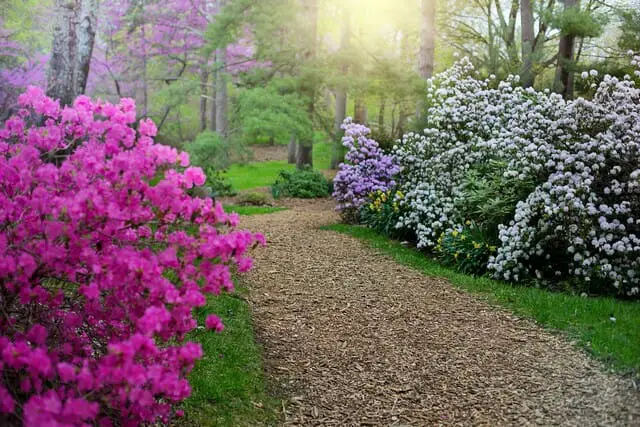
Conclusion: Why You Should Plant Rhododendrons and How to Keep them Maintained
Rhododendrons are also ideal for gardens and farming as the flowers attract many bees. The bright colors and abundance of blooming flowers will attract bees. Once the bees are in the vicinity of your plants, they will land on the flowers of the crops you are harvesting and carry pollen from one crop to another. The pollination from male to female blooms is what makes the flowers produce crops.
Oftentimes, the flowers of these crops can pollinate by wind alone, but when that cannot be achieved, they rely on bees to help carry the pollen from flower to flower. Rhododendrons are ideal for adding to any farm or garden because of the bright, colorful flowers that the plant produces.
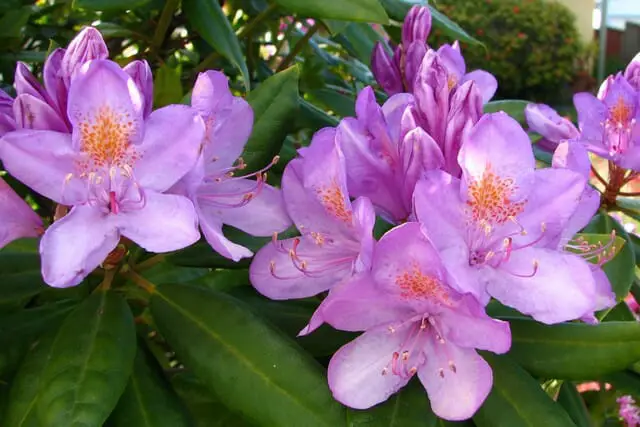
If adding rhododendrons to your home or garden, you should plan to prune them each year in late winter so that they stay full without becoming leggy.
In the event they are neglected and become overgrown, you should cut back the old growth by taking off several inches of the rhododendron branches. If rhododendron overgrowth is too severe, prune the rhododendron down to around 6 inches (15.24 cm) tall, leaving one main branch of the entire plant intact in case it cannot survive the severe pruning.
